Bay Area Rapid Transit rolling stock
| Part of a series of articles on |
 |
The rolling stock of the Bay Area Rapid Transit (BART) system's heavy rail component consists of 662 self-propelled electric multiple units, built from three separate orders.[1] To run a typical peak morning commute, BART requires 579 cars. Of those, 535 are scheduled to be in active service; the others are used to build up four spare trains (essential for maintaining on-time service).[1][2] At any one time, the remaining 90 cars are in for repair, maintenance, or some type of planned modification work.[3] All trains on the separate automated guideway transit line are in regular use without spares. Bombardier Transportation is manufacturing a complete replacement of the mainline fleet, due to be delivered in batches by Fall 2021. The first ten cars of this replacement fleet entered service in 2018, with all expected to enter service by 2022. With the withdrawal and retirement of the older fleet, there will be 775 vehicles in total, with long term goals of eventually increasing this to 1,081 cars. Eight light rail diesel multiple units are being used on a recent spur line.
The mainline track gauge is 5 ft 6 in (1,676 mm) Indian gauge, significantly wider than the near-universal 4 ft 8 1⁄2 in (1,435 mm) standard gauge used on freight railroads and most rapid transit systems. It also uses flat-edge rail, rather than typical rail that angles slightly inward. These factors have complicated maintenance of the system, as it requires custom wheelsets, brake systems, and track maintenance vehicles.[4] Stations have a platform height of 39 inches (991 mm).[5] A full consist, which will fill the system's platforms, is limited to ten units, equaling 710 feet (216 m) (assuming A cars on the ends). The automated guideway transit line utilizes off-the-shelf cable car technology developed by DCC Doppelmayr Cable Car: the Cable Liner.
Original fleet
A and B series
| A Car | |
|---|---|
 | |
| In service | 1972-present |
| Manufacturer | Rohr Industries |
| Constructed | 1968–1971 |
| Entered service | 1972 |
| Refurbishment |
1995 2014 |
| Number built | 59 |
| Capacity |
60 (seated) 200 (crush load) |
| Operator(s) | 1 |
| Depot(s) |
Colma Yard Concord Yard Hayward Complex Richmond Yard |
| Specifications | |
| Car length | 75 ft (23 m) |
| Floor height | 39 in (990 mm) |
| Entry | level |
| Doors | 4 |
| Maximum speed | 80 mph (130 km/h) |
| Traction motors |
Westinghouse (original) ADtranz (refurbish) |
| Acceleration | 3.0 mph/s (4.8 km/(h⋅s)) |
| Train heating |
Thermo King (original) Westcode (refurbish) |
| Electric system(s) | 1,000 V DC third rail |
| Current collection method | contact shoe |
| Minimum turning radius | 120 m (390 ft) |
| Coupling system | WABCO N -3 |
| Track gauge | 5 ft 6 in (1,676 mm) Indian gauge |
| B Car | |
|---|---|
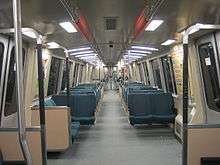 | |
| Number built | 389 |
| Specifications | |
| Car length | 70 ft (21 m) |
| Notes | |
| Same specifications as A cars except where noted | |
The A and B cars were built from 1968 to 1971 by Rohr Industries, an aerospace manufacturing company that had recently started mass-transit equipment manufacturing. The A cars were designed as leading or trailing cars only, with an aerodynamic fiberglass operator's cab housing train control equipment and BART's two-way communication system, and extending 5 feet (1.52 m) longer than the B- and C-cars. A and B cars can seat 60 passengers comfortably, and under crush load, carry over 200 passengers.[2] B cars have no operator's cab and are used in the middle of trains to carry passengers only. Currently, BART operates 59 A cars and 389 B cars.[6][7] The BART A cars have a larger cab window than the C cars, allowing riders to look out of the front or the back of the train.
C series
| C1 Car | |
|---|---|
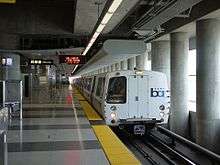 | |
| Manufacturer | Alstom |
| Constructed | 1987–1989 |
| Number built | 150 |
| Number in service | 150 |
| Capacity |
56 (seated) 200 (crush load) |
| Specifications | |
| Traction motors | Westinghouse 1463 |
| Train heating | ? |
| Notes | |
| same specs as B car except where noted | |
| C2 Car | |
|---|---|
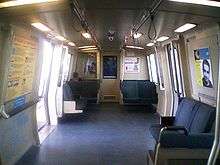 A Demonstration Car (modified C2 car) with accommodations for both wheelchairs and bicycles. This car also has hand straps. | |
| Manufacturer | Morrison-Knudsen |
| Constructed | 1994-1996[8] |
| Number built | 80 |
| Notes | |
| same specs as C1 car except where noted | |
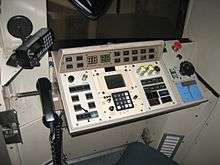


The C cars feature a fiberglass operator's cab and control and communications equipment like the A cars, but do not have the aerodynamic nose, allowing them to be used as middle cars as well. This allows faster train-size changes without having to move the train to a switching yard. C cars can seat 56 passengers and under crush load accommodate over 200 passengers.[2] The first C cars, referred to as C1 cars, were built by Alstom between 1987 and 1989.[9] The second order of C cars, built by Morrison-Knudsen (now Washington Group International), are known as C2 cars. The C2 cars were identical to the C1 cars but featured an interior with a blue/gray motif. At the time of their construction, the C2 cars also featured flip-up seats which could be folded to accommodate wheelchair users; these seats were later removed during refurbishment. Currently, BART operates 150 C1 cars and 80 C2 cars. The "C" cars have a bright white segment as the final approximately two feet (61 cm) of the car at their cab end.
Refurbishments
Prior to the introduction of the C2 cars, the seats and carpeted flooring in all the cars were brown. In 1995, BART contracted with ADtranz (acquired by Bombardier Transportation in 2001) to refurbish and overhaul the 439 original Rohr A- and B-cars, updating the old brown fabric seats to less-toxic and easier-to-clean,[10] light-blue polyurethane seats and bringing the older cars to the same level of interior amenities as the C2 fleet. The project was completed in 2002. The A, B, and C cars were all given 3-digit numbers originally, but when refurbished 1000 was added to the number of each individual A/B car (e.g. car 633 would become 1633). The C2 cars are numbered in the 2500 series; the C/C1 cars still have 3-digit numbers.
Because one of the original design goals was for all BART riders to be seated, the older cars had fewer provisions such as grab bars for standing passengers. In the late 2000s BART began modifying some of the C2 cars to test features such as hand-straps and additional areas for luggage, wheelchairs and bicycles. These new features were later added to the A, B, and C1 cars.
Prior to 2012, all BART cars featured upholstered seats. It was reported in 2011 that several strains of molds and bacteria were found on fabric seats on BART trains, even after wiping with antiseptic. These included bacteria from fecal contamination.[11] In April, BART announced it would spend $2 million in the next year to replace the dirty seats.[12] The new seats would feature vinyl-covered upholstery which would be easier to clean.[13] The transition to the new seats was completed in December 2014.[14]
Originally all the cars had carpeted flooring. Due to similar concerns regarding cleanliness, the carpeting in all of the cars has been removed.[15] The A and B, and C2 cars now feature vinyl flooring in either grey or blue coloring, while the C1 cars feature a spray-on composite flooring.
Traction motors
Prior to rebuilding,[16] the Direct Current (DC) traction motors used on the 439 Rohr BART cars were model 1463 with chopper controls from Westinghouse, who also built the automatic train control system for BART. The Rohr cars were rebuilt with ADtranz model 1507C 3-phase alternating current (AC) traction motors with insulated-gate bipolar transistor (IGBT) inverters. The Westinghouse motors are still in use on the Alstom C (C1) and Morrison-Knudsen C2 cars and the motors that were removed from the Rohr cars were retained as spare motors for use on them. Cars have a starting accelerating of 3.0 mph/s or 4.8 km/(h⋅s) and are capable of holding that acceleration up to 31 mph (50 km/h). Residual acceleration at 80 mph (130 km/h) is 0.78 mph/s or 1.26 km/(h⋅s). Braking rates range from 0.45 mph/s or 0.72 km/(h⋅s) up to 3.0 mph/s or 4.8 km/(h⋅s) (full service rate).[17]
The HVAC system on the Rohr BART cars before rehabilitation were built by Thermo King, when it was a subsidiary of Westinghouse; it is now a subsidiary of Ingersoll Rand. The current HVAC systems on the rebuilt Rohr-built Gen 1 cars were built by Westcode and possibly also ADtranz who had subcontracted the HVAC system to Westcode.[18]
Noise
Many BART passengers have noted that the system is noisy, with a 2010 survey by the San Francisco Chronicle measuring up to 100 decibels (comparable to the noise level of a jackhammer) in the Transbay Tube between San Francisco and Oakland, and still more than 90 decibels in 23 other locations.[19] According to BART, the noise in the tunnel used to be "compared to banshees, screech owls, or Doctor Who's TARDIS run amok".[20]
However, then-chief BART spokesperson Linton Johnson stated that BART averages 70–80 dB, below the danger zone, and according to a 1997 study by the National Academy of Sciences, BART ranks as among the quietest transit systems in the nation.[21][22] Critics have countered that this study analyzed straight, above-ground portions of different systems throughout the country at 30 mph (48 km/h), which is not representative of actual operating conditions. Much of BART is under ground and curvy, even in the Transbay Tube, and has much higher peak operating speeds than many other systems in the country.[22]
Train noise on curves is caused by the wheels slipping along the rails. This slippage also causes noise and surface damage called corrugation. The process by which the noise and corrugation occur is:[22]
- Pairs of wheels are attached to one another with an axle such that they must have the same rotational speed, but on a curve the distances the outer and inner wheels travel are different. As a result, the wheels must slip along the rails.
- This slippage causes the wheel and track to wear and become uneven (corrugated).
- This corrugation causes more noise and corrugation, not only in the original location but elsewhere in the system.
In 2015, after replacing 6,500 feet (1,981 m) and grinding down (smoothing) 3 miles (4.8 km) of rail in the tube, BART reported a reduction of noise there and positive feedback from riders.[20] BART also announced that the new train cars expected to enter service in December 2016 (see below) will be quieter, thanks to "'micro-plug' doors [that] help seal out noise".[23]
Fleet of the Future (D and E series)
| D Car | |
|---|---|
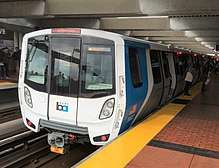 | |
| In service | 2018-present |
| Manufacturer | Bombardier Transportation |
| Designer | Morelli Designers |
| Replaced | A, B, C series |
| Constructed | 2012–2022 (estimated)[24] |
| Entered service | January 19, 2018 |
| Number under construction | 310 |
| Capacity | 51 (seated) |
| Depot(s) |
Colma Yard Concord Yard Hayward Complex Richmond Yard |
| Specifications | |
| Car length | 70 ft (21 m) |
| Platform height | 39 in (990 mm) |
| Entry | Level |
| Doors | 6 |
| Maximum speed | 80 mph (130 km/h) |
| Electric system(s) | 1,000 V DC third rail |
| Current collection method | contact shoe |
| Minimum turning radius | 120 m (390 ft) |
| Coupling system | Scharfenberg |
| Track gauge | 5 ft 6 in (1,676 mm) Indian gauge |
| E Car | |
|---|---|
 | |
| Number under construction | 465 |
| Capacity | 56 (seated) |
| Notes | |
| same specs as D car except where noted | |
In a 2010 APTA study, the average age of BART's mainline fleet was reported to be 30 years, longer than the usual lifespan of 25 years. Despite the purchase of newer cars over the years, the majority of the active fleet in 2016 was over 40 years old and had traveled over a million miles. Because of this, they have been increasing prone to frequent breakdowns and repairs, decreasing the number of available cars and in turn increasing congestion, especially with the need to increase the fleet size for extensions to the network.[25] Consequently, in 2009, BART began the process of expanding and replacing its railcar fleet.[26] By 2010, it had received proposals from five suppliers, and on May 10, 2012, it awarded a $896.3 million contract to Canadian railcar manufacturer Bombardier Transportation with an order for 410 new cars, split into a base order of 260 cars and a first option order of 150 additional cars.[27][28] The car was designed by Morelli Designers, an industrial design firm based in Montréal, Canada.[29] On November 21, 2013, BART purchased 365 more cars, for a total fleet size of 775 new railcars, while also accelerating the delivery schedule by 21 months (from 10 cars per month up to 16 cars per month) and lowering procurement costs by approximately $135 million.[30][31] According to the contract, at least ⅔ of the contract’s amount must be spent on U.S.-built parts.
There are two different types of car configurations for the new fleet; a cab car (D cars), which will make up 40% of the fleet, or, 310 cars, and a non-cab car (E cars), which will make up the remainder of the fleet, or, 465 cars.[31][32] All cars are to be equipped with bike racks, new vinyl seats (54 per car), and a brand new passenger information system which will display next stop information.[33]
A major difference from the older cars is the presence of an extra set of doorways on each side of the new cars to speed up boarding and alighting.[34] They also include redesigned seating, bike racks, digital displays that display travel information, and automatic announcements.[35] Due to potential access issues for people with disabilities, the pilot car layout was modified by the BART board in February 2015 to include two wheelchair spaces in the center of the car, as well as alternative layouts for bike and flexible open spaces.[36]
The first test car was unveiled in April 2016;[23] upon approval, the first 10 cars were expected to be in service in December 2016, and at least 20 by December 2017.[23] This was delayed several times until the production cars were expected to be delivered in October 2017.[24] Delivery of all 775 cars was initially expected to be completed by Fall 2022,[37] with all cars in service by 2023.[24] Bombardier initially agreed to speed production to have all cars available by the end of 2021 and in service by 2022.
In early November 2017, a test train failed a CPUC regulatory inspection due to door issues, leaving the planned late November revenue service in doubt.[38] The first ten-car train received CPUC certification on January 17, 2018,[39] and began revenue service two days later on January 19.[40] Plans to have 198 new cars by July 2018 did not materialize, and the agency had put only 20 in service at that time.[41]
AGT fleet
| Cable Liner | |
|---|---|
 | |
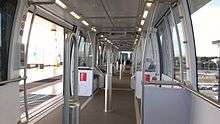 | |
| Manufacturer | DCC Doppelmayr |
| Entered service | 2014 |
| Number built | 4 |
| Capacity | 113 |
| Depot(s) | Doolittle maintenance and storage facility |
| Line(s) served | |
| Specifications | |
| Entry | level |
| Articulated sections | 3 |
| Maximum speed | 30 mph (48 km/h) |
| Engine type | stationary cable motors |
The Coliseum–Oakland International Airport line uses a completely separate and independently operated fleet as it uses off-the-shelf cable car-based automated guideway transit technology. The fleet consists of four Cable Liner trains built by DCC Doppelmayr Cable Car arranged as three-car sets,[42] totaling twelve cars. The system is designed to be expanded to four-car trains with a capacity of 148 passengers in the future if necessary.
eBART fleet
| Stadler GTW | |
|---|---|
|
Stadler GTW near Pittsburg Center station in May 2018 | |
|
Interior of the eBART DMU | |
| Manufacturer | Stadler Rail |
| Built at | Bussnang, Switzerland |
| Constructed | 2014–2018 |
| Entered service | 2018 |
| Number built | 8 |
| Capacity |
104 (seated) 96 (standing)[43] |
| Operator(s) | 1 |
| Depot(s) | Antioch Yard |
| Line(s) served | eBART |
| Specifications | |
| Car length | 132 ft (40 m)[43] |
| Entry | level |
| Doors | 4 |
| Articulated sections | 3 |
| Maximum speed | 75 mph (121 km/h)[43] |
| Engine type | Diesel |
| UIC classification | 2'+Bo+2' |
| Track gauge | 1,435 mm (4 ft 8 1⁄2 in) standard gauge |
eBART is a spur line built to different design standards than the majority of the mainline; it is non-electrified 4 ft 8 1⁄2 in (1,435 mm) standard gauge and intended for service by light rail. The vehicle procurement for the line included eight Stadler GTW trains, with two options to purchase six more. Stadler was the sole bidder on the contract.[44] The first was delivered in June 2016.[45] The trains are diesel multiple units (DMU's) with 2/6 articulated power units, and are based on models previously used in Austin, Dallas and New Jersey.[23][46]
Track geometry cars
| Builder | Model | In service | Note | Image |
|---|---|---|---|---|
| Plasser & Theurer | EM 110c | 19??–present |  | |
| MER MEC | Roger MM 600 | On order[47] | ||
References
- 1 2 Chinn, Jerold (January 29, 2015). "Long wait ahead for longer BART trains". San Francisco Bay Area. Retrieved 2015-09-29.
BART explains it has total of 662 trains, but about 535 are in service during peak commute times, about 86.5 percent of its fleet. BART said it runs more of its fleet than any other major transit agency despite having the oldest trains in the nation.
- 1 2 3 Cabanatuan, Michael (April 10, 2010). "BART can't keep pace with rising 'crush loads'". SFGate.
- ↑ ""Why can't the trains be longer?" Some background to explain". BART. September 25, 2008. Archived from the original on August 27, 2009. Retrieved August 23, 2009.
- ↑ Gafni, Matthias (March 25, 2016). "Has BART's cutting-edge 1972 technology design come back to haunt it?". San Jose Mercury News. Retrieved March 28, 2016.
- ↑ "BART-San Francisco Airport Extension Final Environmental Impact Report/Final Environmental Impact Statement". Federal Transit Administration. June 1996. p. 3-501 – via Internet Archive.
- ↑ "BART – Car Types". Bay Area Rapid Transit. Retrieved August 23, 2009.
- ↑ "FY08 Short Range Transit Plan and Capital Improvement Program" (PDF). BART. September 2007. Archived from the original (PDF) on February 29, 2008. Retrieved November 11, 2007.
- ↑ http://www.bart.gov/sites/default/files/docs/PosterTimeline_v2.pdf
- ↑ "BART Car ills". San Jose Mercury News. February 23, 1990. Retrieved August 23, 2009 – via Newsbank.com.
- ↑ "New seats now in all trains". Bay Area Rapid Transit (BART). January 2, 2015. Retrieved December 28, 2015.
- ↑ Elinson, Zusha (March 5, 2011). "BART Seats: Where Bacteria Blossom". Bay Citizen. Accessed March 8, 2011.
- ↑ Elinson, Zusha (April 12, 2011). "BART Plans to Spend $2 Million to Replace Grimy Seats". Bay Citizen. Accessed April 13, 2011.
- ↑ Elinson, Zusha (April 6, 2012). "BART's New Seats (a Few) Make Debut". The New York Times. Retrieved January 24, 2015.
- ↑ "New seats now in all trains". Bay Area Rapid Transit (BART). January 2, 2015. Retrieved January 24, 2015.
- ↑ "BART carpet: Like wool seats, another relic gone for good". bart.gov. Bay Area Rapid Transit (BART). 10 August 2015. Retrieved 11 April 2016.
- ↑ "BART Renovation Nears Completion". Business Wire. October 9, 2003. Retrieved January 24, 2014.
- ↑ http://faculty.ist.unomaha.edu/winter/publications/2001/Bay_Area_Rapid_Transit_District_Advanced_Automated_Train_Control_System_Case_Study_Description.pdf
- ↑ "WESTCODE, INC., Plaintiff, v. DAIMLER CHRYSLER RAIL SYSTEMS (NORTH AMERICA) INC., f/k/a AEG TRANSPORTATION SYSTEMS, INC., Defendant" (PDF).
- ↑ Cabanatuan, Michael (2010-09-07). "Noise on BART: How bad is it and is it harmful?". SFGate. Retrieved 2016-04-22.
- 1 2 "Riders notice a quieter ride following first of two tube shutdowns". www.bart.gov. 2015-08-13. Retrieved 2016-04-22.
- ↑ Nelson, J. T (1997). "TCRP Report 23: Wheel–Rail Noise Control Manual" (PDF). Washington, D.C.: National Research Council. Retrieved September 22, 2015.
- 1 2 3 Oakland North Radio, October 24, 2010. Accessed April 10, 2012.
- 1 2 3 4 "Onsite testing begins for BART's first new train car". www.bart.gov. 2016-04-06. Retrieved 2016-04-22.
- 1 2 3 BALDASSARI, ERIN (5 October 2017). "BART's new train cars delayed (again): target is now Thanksgiving". East Bay Times. Retrieved 5 October 2017.
- ↑ Grossberg, Adam (2016-01-26). "After a Million Miles, BART Cars Are Hella Old". KQED News. Retrieved 2018-01-20.
- ↑ "New Train Car Project". BART.gov. Retrieved 2018-01-20.
- ↑ Richman, Josh (May 10, 2012). "BART board approves contract for 410 new train cars". San Jose Mercury News. Retrieved May 11, 2012.
- ↑ Bowen, Douglas John (May 11, 2012). "BART taps Bombardier; U.S. content at issue". Railway Age. Retrieved May 11, 2012.
- ↑ "BART – San Francisco" (in French). Morelli Designers. Retrieved July 2, 2015.
- ↑ "BART Board approves additional 365 cars for Fleet of the Future". BART. November 21, 2013. Retrieved November 26, 2013.
- 1 2 "Board Meeting Agenda" (PDF). San Francisco Bay Area Rapid Transit District. November 21, 2013. pp. 91–92. Retrieved December 5, 2013.
- ↑ "New Train Car Project; New Features". Bay Area Rapid Transit (BART). 2013. Retrieved July 2, 2014.
- ↑ "New Train Car Project New Features". Bay Area Rapid Transit (BART). 2013. Retrieved December 5, 2013.
- ↑ Nguyen, Alexander (2015-10-29). "New 3-Door BART Cars Could Speed Boarding Times, Officials Say". Walnut Creek Patch. Retrieved 2018-01-20.
- ↑ Morse, Jack (2016-04-06). "Photos: First Look Inside That New BART Car, Bike Racks And All". SFist. Retrieved 2018-01-20.
- ↑ Cuff, Denis (February 26, 2015). "BART changes new train car design to satisfy disabled riders' concerns". Contra Costa Times. Retrieved February 28, 2015.
- ↑ "New Train Car Project Delivery Plan". Bay Area Rapid Transit (BART). 2014. Retrieved July 2, 2014.
- ↑ Rodriguez, Joe Fitzgerald (November 7, 2017). "BART's new train cars fail regulatory test, possibly delaying rollout". San Francisco Examiner. Retrieved November 8, 2017.
- ↑ Cabanatuan, Michael (January 18, 2018). "New BART rail cars approved for service". San Francisco Chronicle.
- ↑ Hollyfield, Amy (2018-01-19). "BART's Fleet of the Future put into service today". ABC7 San Francisco. Retrieved 2018-01-20.
- ↑ Matier, Phil (16 July 2018). "BART's Fleet Of The Future Is Already Spending The Present Getting Repaired". KPIX. Retrieved 17 July 2018.
- ↑ "BART Board sets fares for BART to Oakland International Airport service". Bay Area Rapid Transit (BART). June 12, 2014. Retrieved 2014-08-17.
- 1 2 3 COETSEE, ROWENA (30 June 2017). "Local pols get sneak peek at eBART train". The Mercury News. Retrieved 25 November 2016.
- ↑ "BART unveils Antioch eBART train". Railway Gazette. 4 July 2016. Retrieved 21 October 2016.
- ↑ "East Contra Costa BART Extension (eBART) Implementation". Bay Area Rapid Transit (BART). May 19, 2015. Retrieved 2015-08-09.
- ↑ "Stadler Rail delivers trains to Oakland". Stadler Rail. April 26, 2014. Archived from the original on March 4, 2016. Retrieved 2015-08-09.
- ↑ "San Francisco track geometry car ordered". Railway Gazette. 13 April 2016. Retrieved 21 October 2016.